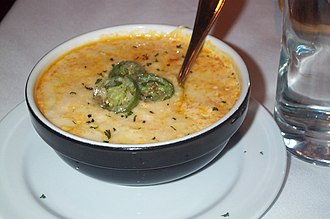Creaming (cooking)
Creaming (cooking)[edit]

Creaming is a fundamental technique in baking and cooking that involves blending ingredients, typically butter and sugar, to create a smooth, fluffy mixture. This process is essential in many recipes, particularly in the preparation of cakes, cookies, and other baked goods, as it helps to incorporate air into the batter, contributing to the lightness and texture of the final product.
Process[edit]
The creaming method begins with the selection of ingredients. Butter should be at room temperature to ensure it blends smoothly with sugar. The sugar can be granulated, brown, or a combination, depending on the desired flavor and texture.
To cream butter and sugar, place them in a mixing bowl and use a hand mixer or stand mixer fitted with a paddle attachment. Start mixing at a low speed to combine the ingredients, then increase to medium-high speed. The mixture should be beaten until it becomes pale, light, and fluffy. This process can take several minutes, depending on the quantity and the power of the mixer.
The creaming process is crucial because it creates a matrix of air bubbles trapped in the fat, which expands during baking, resulting in a tender and airy texture. Over-creaming can lead to a dense texture, as the butter may become too soft and lose its ability to hold air.
Applications[edit]
Creaming is used in a variety of recipes, including:
- Cakes: The creaming method is often used in butter cakes and pound cakes, where the lightness of the batter is essential for the cake's texture.
- Cookies: Many cookie recipes, such as chocolate chip cookies, begin with creaming butter and sugar to ensure a tender crumb.
- Frostings: Creaming is also used in making buttercream frosting, where butter is creamed with sugar to create a smooth and spreadable icing.
Variations[edit]
While the traditional creaming method involves butter and sugar, variations exist depending on the recipe requirements. For instance, in some recipes, shortening or margarine may be used in place of butter. Additionally, other ingredients like eggs or vanilla extract may be added during the creaming process to enhance flavor and texture.
Creamed Corn[edit]

Creaming is not limited to baking; it is also used in savory dishes such as creamed corn. In this dish, corn kernels are cooked with cream, butter, and sometimes flour to create a rich, creamy side dish. The process involves cooking the corn until tender and then blending it with the other ingredients to achieve a smooth consistency.
Related Techniques[edit]
- Whipping: Similar to creaming, whipping involves incorporating air into ingredients, but it is typically used with cream or egg whites.
- Folding: A gentle mixing technique used to combine light ingredients, such as whipped cream or beaten egg whites, with heavier mixtures.
Related Pages[edit]
Ad. Transform your life with W8MD's Budget GLP-1 injections from $75


W8MD offers a medical weight loss program to lose weight in Philadelphia. Our physician-supervised medical weight loss provides:
- Weight loss injections in NYC (generic and brand names):
- Zepbound / Mounjaro, Wegovy / Ozempic, Saxenda
- Most insurances accepted or discounted self-pay rates. We will obtain insurance prior authorizations if needed.
- Generic GLP1 weight loss injections from $75 for the starting dose.
- Also offer prescription weight loss medications including Phentermine, Qsymia, Diethylpropion, Contrave etc.
NYC weight loss doctor appointmentsNYC weight loss doctor appointments
Start your NYC weight loss journey today at our NYC medical weight loss and Philadelphia medical weight loss clinics.
- Call 718-946-5500 to lose weight in NYC or for medical weight loss in Philadelphia 215-676-2334.
- Tags:NYC medical weight loss, Philadelphia lose weight Zepbound NYC, Budget GLP1 weight loss injections, Wegovy Philadelphia, Wegovy NYC, Philadelphia medical weight loss, Brookly weight loss and Wegovy NYC
|
WikiMD's Wellness Encyclopedia |
| Let Food Be Thy Medicine Medicine Thy Food - Hippocrates |
Medical Disclaimer: WikiMD is not a substitute for professional medical advice. The information on WikiMD is provided as an information resource only, may be incorrect, outdated or misleading, and is not to be used or relied on for any diagnostic or treatment purposes. Please consult your health care provider before making any healthcare decisions or for guidance about a specific medical condition. WikiMD expressly disclaims responsibility, and shall have no liability, for any damages, loss, injury, or liability whatsoever suffered as a result of your reliance on the information contained in this site. By visiting this site you agree to the foregoing terms and conditions, which may from time to time be changed or supplemented by WikiMD. If you do not agree to the foregoing terms and conditions, you should not enter or use this site. See full disclaimer.
Credits:Most images are courtesy of Wikimedia commons, and templates, categories Wikipedia, licensed under CC BY SA or similar.
Translate this page: - East Asian
中文,
日本,
한국어,
South Asian
हिन्दी,
தமிழ்,
తెలుగు,
Urdu,
ಕನ್ನಡ,
Southeast Asian
Indonesian,
Vietnamese,
Thai,
မြန်မာဘာသာ,
বাংলা
European
español,
Deutsch,
français,
Greek,
português do Brasil,
polski,
română,
русский,
Nederlands,
norsk,
svenska,
suomi,
Italian
Middle Eastern & African
عربى,
Turkish,
Persian,
Hebrew,
Afrikaans,
isiZulu,
Kiswahili,
Other
Bulgarian,
Hungarian,
Czech,
Swedish,
മലയാളം,
मराठी,
ਪੰਜਾਬੀ,
ગુજરાતી,
Portuguese,
Ukrainian